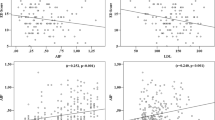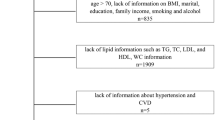Abstract
The aim of this study is to evaluate the association between physical activity level and physical fitness with erectile dysfunction in men aged 40–75 years. We examined 180 men aged 40–75 years. The individuals were evaluated for age, presence of dyslipidemia and smoking and for anthropometric parameters for the characterization of body mass index. For assessing the level of physical fitness, a test was performed to measure the indirect maximum oxygen consumption. The evaluation of erectile function was made by the International Index of Erectile Function questionnaire and assessment of physical activity level by the International Physical Activity questionnaire in its short version. This study showed that younger men with higher physical activity and better physical fitness are less likely to suffer from erectile dysfunction. Multivariable analysis through logistic regression showed that age (odds ratio (OD)=1.15; 95% confidence interval (95% CI)=1.07–1.23), physical activity (OD=10.38; 95% CI=3.94–27.39) and physical fitness (OD=4.62; 95% CI=1.75–12.25) were independent variables associated with erectile dysfunction. This study reinforces the concept that healthy habits have a direct effect on erectile function.
This is a preview of subscription content, access via your institution
Access options
Subscribe to this journal
Receive 8 print issues and online access
$259.00 per year
only $32.38 per issue
Buy this article
- Purchase on Springer Link
- Instant access to full article PDF
Prices may be subject to local taxes which are calculated during checkout


Similar content being viewed by others
References
Feldman HA, Goldstein I, Hatzichristou DG, Krane RJ, McKinlay JB . Impotence and its medical and psychosocial correlates: results of the Massachusetts Male Aging Study. J Urol 1994; 151: 54–61.
O’Leary MP, Rhodes T, Girman CJ, Jacobson DJ, Roberts RO, Lieber MM et al. Distribution of the Brief Male Sexual Inventory in community men. Int J Impot Res 2003; 15: 185–191.
Jonler M, Moon T, Brannan W, Stone NN, Heisey D, Bruskewitz RC . The effect of age, ethnicity and geographical location on impotence and quality of life. Br J Urol 1995; 75: 651–655.
Johannes CB, Araujo AB, Feldman HA, Derby CA, Keinman KP, McKinlay JB . Incidence of erectile dysfunction in men 40 to 69 years old: longitudinal results from The Massasuchetts Male Aging Study. J Urol 2000; 163: 460–463.
Moreira Jr ED, Abdo CHN, Torres EB, Lôbo CFL, Fittipaldi JAS . Prevalence and correlates of erectile dysfunction: results of the Brazilian study of sexual behavior. Urology 2001; 58: 583–588.
Morillo LE, Diaz J, Estevez E, Costa A, Mendez H, Davila H et al. Prevalence of erectile dysfunction in Colombia, Ecuador, and Venezuela: a population-based study (DENSA). Int J Impot Res 2002; 14 (Suppl2): S10–S18.
Pate RR, Pratt M, Blair SN, Haskell WL, Macera CA, Bouchard C et al. Physical activity and public health. A recommendation from the Centers for Disease Control and Prevention and the American College of Sports Medicine. JAMA 1995; 273: 402–407.
Esposito K, Giugliano F, Di Palo C, Giugliano G, Marfella R, D’Andrea F et al. Effect of lifestyle changes on erectile dysfunction in obese men: a randomized controlled trial. JAMA 2004; 291: 2978–2984.
Rosen RC, Cappelleri JC, Smith MD, Lipsky J, Peña BM . Development and evaluation of an abridged, 5-item version of the international index of erectile function (IIEF-5) as a diagnostic tool for erectile dysfunction. Int J Impot Res 1999; 11: 319–326.
Matsudo SM, Araújo TL, Matsudo VKR, Andrade DR, Andrade EL, Oliveira LC et al. Questionário Internacional de Atividade Física (IPAQ): estudo de validade e reprodutibilidade no Brasil. Rev Bras Ativ Saude 2001; 10: 5–18.
World Health Organization. Obesity: Preventing and Managing the Global Epidemic. World Health Organization: Report of a WHO Consulation. Geneva, 1998 (Technical Report Series, No. 894).
American College of Sport Medicine. Guideline for Graded Exercise Testing and Exercise Prescrition. Lea & Febiger: Philadelphia, 1980.
Ferraz MB, Ciconelli RM . Tradução e adaptação cultural do Índice Internacional de Função Erétil para a língua portuguesa. Rev Bras Med 1998; 55: 35–40.
Nolazco C, Bellora O, Lopez M, Surur D, Vazquez J, Rosenfeld C et al. Prevalence of sexual dysfunctions in Argentina. Int J Impot Res 2004; 16: 69–72.
Rosen RC, Fisher WA, Eardley I, Niederberger C, Nadel A, Sand M . The multinational Men's Attitudes to Life Events and Sexuality (MALES) study: I prevalence of erectile dysfunction and related health concerns in the general population. Curr Med Res Opin 2004; 20: 607–617.
Gatti A, Mandosi E, Fallarino M, Radicioni A, Morini E, Maiani F et al. Metabolic syndrome and erectile dysfunction among obese non-diabetic subjects. J Endocrinol Invest 2009; 6: 542–545.
Gündüz MI, Gümüs BH, Sekuri C . Relationship between metabolic syndrome and erectile dysfunction. Asian J Androl 2004; 4: 355–358.
Bal K, Oder M, Sahin AS, Karata CT, Demir O, Can E et al. Prevalence of metabolic syndrome and its association with erectile dysfunction among urologic patients: metabolic backgrounds of erectile dysfunction. Urology 2007; 2: 356–360.
Haskell WL, Lee IM, Pate RR, Powell KE, Blair SN, Franklin BA et al. Physical activity and public health: updated recommendation for adults from the American College of Sports Medicine and the American Heart Association. Med Sci Sports Exerc 2007; 39: 1423–1434.
Bacon CG, Mittleman MA, Kawachi I, Giovannucci E, Glasser DB, Rimm EB . Sexual function in men older than 50 years of age: results from the health professionals follow-up study. Ann Intern Med 2003; 139: 161–168.
Bacon CG, Mittleman MA, Kawachi I, Giovannucci E, Glasser DB, Rimm EB . A prospective study of risk factors for erectile dysfunction. J Urol 2006; 176: 217–221.
Cheng JY, Ng EM, Ko JS, Chen RY . Physical activity and erectile dysfunction: meta-analysis of population-based studies. Int J Impot Res 2007; 19: 245–252.
Kongkanand A . Prevalence of erectile dysfunction in Thailand. Thai Erectile Dysfunction Epidemiological Study Group. Int J Androl 2000; 23 (Suppl 2): 77–80.
Kratzik CW, Lackner JE, Märk I, Rücklinger E, Schmidbauer J, Lungimayr G et al. How much physical activity is needed to maintain erectile function? Results of the Androx Vienna Municipality Study. Eur Urol 2009; 55: 509–517.
Esposito K, Ciotola M, Giugliano F, Maiorino MI, Autorino R, De Sio M et al. Effects of intensive lifestyle changes on erectile dysfunction in men. J Sex Med 2009; 1: 243–250.
Kupelian V, Araujo AB, Chiu GR, Rosen RC, McKinlay JB . Relative contributions of modifiable risk factors to erectile dysfunction: results from the Boston Area Community Health (BACH) Survey. Prev Med 2010; 1: 19–25.
Hannan JL, Maio MT, Komolova M, Adams MA . Beneficial impact of exercise and obesity interventions on erectile function and its risk factors. J Sex Med 2009; 3: 254–261.
Maio G, Saraeb S, Marchiori A . Physical activity and PDE5 inhibitors in the treatment of erectile dysfunction: results of a randomized controlled study. J Sex Med 2010; 7: 2201–2208.
American College of Sports Medicine. ACSM position stand on the recommended quantity and quality of exercise for developing and maintaining cardiorespiratory and muscular fitness, and flexibility in healthy adults. Med Sci Sports Exerc 1998; 30: 975–991.
Pollock ML, Franklin BA, Balady GJ, Chaitman BL, Fleg JL, Fletcher B et al. AHA Science Advisory. Resistance exercise in individuals with and without cardiovascular disease: benefits, rationale, safety, and prescription: An advisory from the Committee on Exercise, Rehabilitation, and Prevention, Council on Clinical Cardiology, American Heart Association Position paper endorsed by the American College of Sports Medicine. Circulation 2000; 101: 828–833.
Mazzeo RS CP, Evans WJ, Fiatarone MA, Hagberg J, McAuley E, Startzell J . Exercício e atividade física para pessoas idosas: Posicionamento oficial do American College of Sports Medicine. Revista Brasileira de Atividade Física e Saúde 1998; 3: 48–78.
Fletcher GF, Balady G, Froelicher VF, Hartley LH, Haskell WL, Pollock ML . Exercise standards. A statement for healthcare professionals from the American Heart Association. Writing Group. Circulation 1995; 91: 580–615.
Stratton JR, Levy WC, Cerqueira MD, Schwartz RS, Abrass IB . Cardiovascular responses to exercise. Effects of aging and exercise training in healthy men. Circulation 1994; 89: 1648–1655.
Nottin S, Vinet A, Stecken F, N’Guyen LD, Ounissi F, Lecoq AM et al. Central and peripheral cardiovascular adaptations to exercise in endurance-trained children. Acta Physiol Scand 2002; 175: 85–92.
Fletcher GF, Balady GJ, Amsterdam EA, Chaitman B, Eckel R, Fleg J et al. Exercise standards for testing and training. Circulation 2001; 104: 1694–1740.
Diaz FJ, Montano JG, Melchor MT, Guerrero JH, Tovar JA . Validation and reliability of the 1,000 meter aerobic test. Rev Invest Clin 2000; 52: 44–51.
Sanada K, Midorikawa T, Yasuda T, Kearns CF, Abe T . Development of nonexercise prediction models of maximal oxygen uptake in healthy Japanese young men. Eur J Appl Physiol 2007; 99: 143–148.
Kruel LF, Coertjeans M, Pusch HC . Validade e Fidedignidade do Consumo Máximo de Oxigênio Predito pelo Freqüêncimetro Polar M52. Revista Brasileira de Fisiologia do Exercício 2003; 2: 147–156.
Blomqvist CG, Saltin B . Cardiovascular adaptations to physical training. Ann Rev Physiol 1983; 45: 169–189.
Myers J, Prakash M, Froelicher V, Do D, Partington S, Atwood JE . Exercise capacity and mortality among men referred for exercise testing. N Engl J Med 2002; 346: 793–801.
Moreira Jr ED, Lisboa Lobo CF, Villa M, Nicolosi A, Glasser DB . Prevalence and correlates of erectile dysfunction in Salvador, northeastern Brazil: a population-based study. Int J Impot Res 2002; 14 (Suppl 2): S3–S9.
Kratzik CW, Schatzl G, Lunglmayr G, Rucklinger EJ . The impact of age, body mass index and testosterone on erectile dysfunction. J Urol 2005; 174: 240–243.
Giuliano F, Chevret-Measson M, Tsatsaris A, Reitz C, Murino M, Thonneau P . Prevalence of erectile dysfunction in France: results of an epidemiological survey of a representative sample of 1004 men. Eur Urol 2002; 42: 382–389.
Ugarte y Romano F, Barroso AJ . Prevalencia de disfunción eréctil en México y factores de riesgo asociados. Rev Mex Urologia 2001; 61: 63–76.
Feldman HA, Johannes CB, Derby CA, Kleinman KP, Mohr BA, Araujo AB et al. Erectile dysfunction and coronary risk factors: prospective results from the Massachusetts male aging study. Prev Med 2000; 30: 328–338.
Tan JK, Hong CY, Png DJ, Liew LC, Wong ML . Erectile dysfunction in Singapore: prevalence and its associated factors--a population-based study. Singapore Med J 2003; 44: 20–26.
Abdo CHN, Oliveira Jr WM, Scanavino MT, Martins FG . Disfunção erétil—resultados do estudo da vida sexual do brasileiro. Rev Assoc Med Brás 2006; 52: 424–429.
Tostes RC, Carneiro FS, Lee AJ, Giachini FR, Leite R, Osawa Y et al. Cigarette smoking and erectile dysfunction: focus on NO bioavailability and ROS generation. J Sex Med 2008; 6: 1284–1295.
Mannino DM, Klevens RM, Flanders WD . Cigarette smoking: an independent risk factor for impotence? Am J Epidemiol 1994; 140: 1003–1008.
Author information
Authors and Affiliations
Corresponding author
Ethics declarations
Competing interests
The authors declare no conflict of interest.
Rights and permissions
About this article
Cite this article
Agostini, L., Netto, J., Miranda, M. et al. Erectile dysfunction association with physical activity level and physical fitness in men aged 40–75 years. Int J Impot Res 23, 115–121 (2011). https://doi.org/10.1038/ijir.2011.15
Received:
Revised:
Accepted:
Published:
Issue Date:
DOI: https://doi.org/10.1038/ijir.2011.15
Keywords
This article is cited by
-
Sport, doping and male fertility
Reproductive Biology and Endocrinology (2018)
-
Lifestyle and metabolic approaches to maximizing erectile and vascular health
International Journal of Impotence Research (2012)



